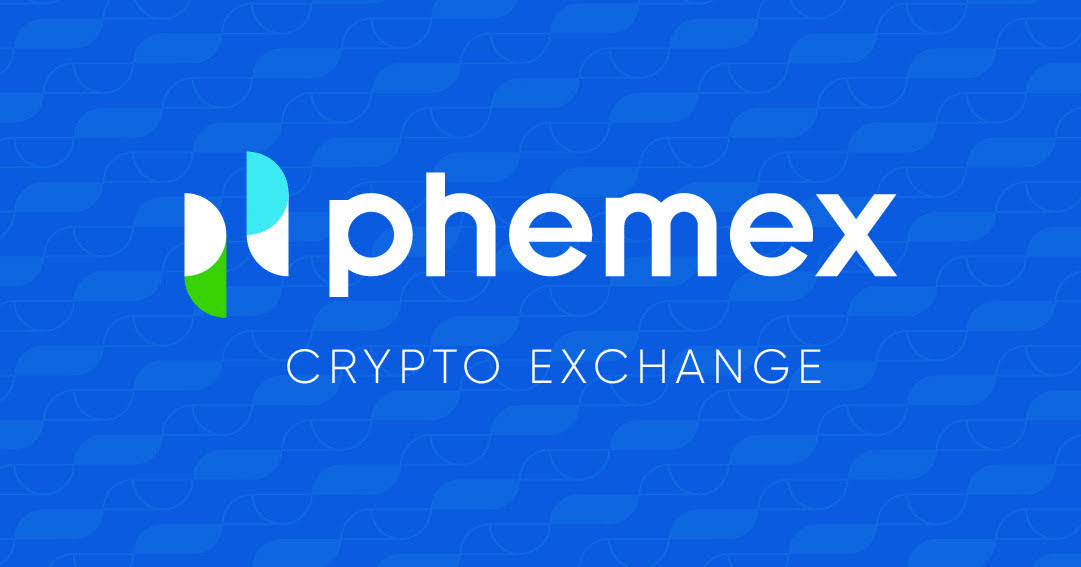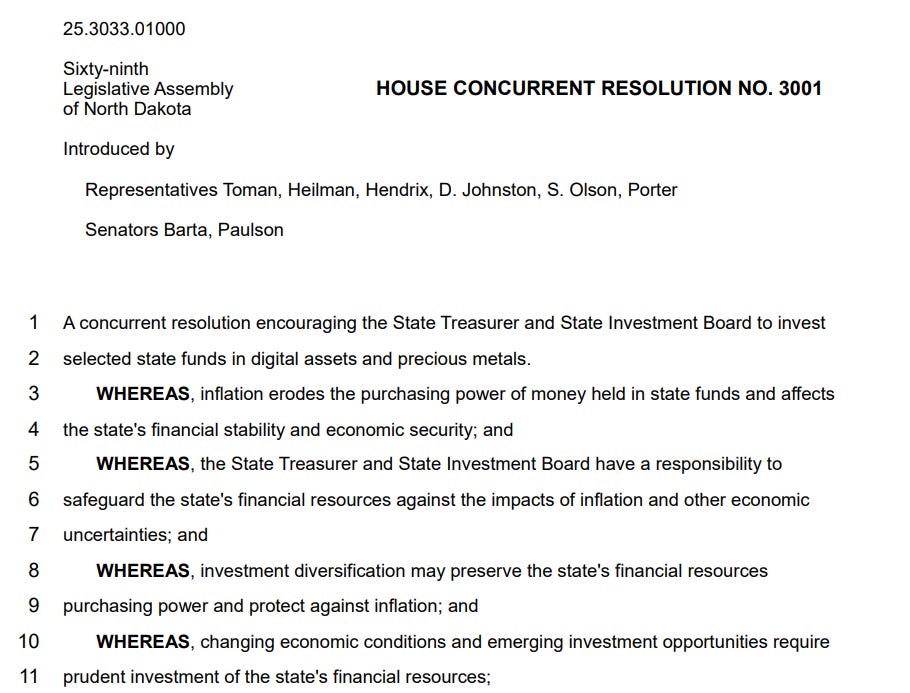The Wolf Den #1115 - States Eye Bitcoin: The Next Big Treasury Asset?
Strategic Bitcoin Reserves
Welcome to The Wolf Den! This is where I share the news, my ideas about the market, technical analysis, education and my random musings. The newsletter is released every weekday and is completely FREE. Subscribe!
Today’s Newsletter Is Made Possible By Phemex!
Join me on Phemex and unlock up to 30,000 USDT in exclusive rewards! Use my link HERE.
Phemex is the most efficient crypto trading and investment platform. Phemex offers over 400 trading pairs, minimal fees, peer to peer trading, derivatives, up to 100x leverage.
Make sure to check if Phemex is available in your jurisdiction.
In This Issue:
States Eye Bitcoin: The Next Big Treasury Asset?
Bitcoin Thoughts And Analysis
Altcoin Charts
Legacy Markets
These Predictions Look Solid
Meta Shareholders Want Bitcoin
The Incoming Treasury Secretary Owns Bitcoin
Staking Wins In The UK
Bitcoin's Big Moment: Fidelity Reveals 2025 Crypto Predictions | Chris Kuiper & Matthew Horne
States Eye Bitcoin: The Next Big Treasury Asset?
It’s 2025, and this much is clear: States want Bitcoin.
This past Friday, two more U.S. states introduced bills to purchase Bitcoin. For those keeping track, New Hampshire and North Dakota are the newest additions to a growing list that includes Alabama, Florida, Pennsylvania, Texas, and Ohio.
Here’s the North Dakota Bill:
Let’s take a closer look at the details of the New Hampshire bill. What stands out immediately is its unique structure, reflecting a distinctly different approach compared to other states. It’s important to remember that bills will naturally vary from state to state, shaped by their individual legislative priorities and processes.
While Bitcoin isn’t explicitly mentioned in the bill—admittedly not the ideal outcome—the term “digital assets” is used. However, further qualifications within the bill help narrow the scope, providing reassurance to skeptics and doubters alike.s and skeptics.
The requirement specifies “a market capitalization over $500 billion averaged over the previous calendar year.” Currently, only one digital asset meets this standard: Bitcoin. Ethereum hasn’t averaged over $500 billion in market capitalization in the past calendar year, achieving that level for only about a month back in 2021. This leaves the door open for Ethereum (or any other asset) in the future but sets a high bar for any potential contenders.
The specified amount represents 10% of public funds, with an estimated $360 million allocated to the reserve. Below is an image offering a clearer view of how the state’s budgeting process works.
The bill specifies that the digital asset must be an exchange-traded product, a criterion currently met exclusively by Bitcoin and Ethereum.
An interesting detail in the bill is that staking is approved but cannot be considered until the $500 billion market cap requirement is met. This proactive inclusion is commendable, as it addresses potential concerns upfront rather than leaving them to be dealt with separately later.
Let’s briefly address some criticism of the bill(s):
I’m well aware of the deeper-rooted differences among various Bitcoiners, but that’s not my focus. My priority is moving the needle of progress forward. It’s why I hosted this announcement, why I write this newsletter five times a week, and why I’ll defend anyone genuinely working toward that goal.
Have we not moved beyond the idea of Bitcoin only? If a state chooses to adopt a digital asset other than Bitcoin in the future, does that spell doom for Bitcoin? Would it diminish its value or derail the progress toward moving beyond fiat? Or could it simply represent another step in the broader journey of digital asset adoption? Even Michael Saylor has moved past this mindset. There’s nothing “sneaky” about the bill—it’s straightforward.
As a side note, I only recently learned about states adopting technology beyond Bitcoin. I wasn’t even aware this was happening until a few days ago. Is it really so crazy for a state to invest in technology they trust and actively use?
Let’s address this one now:
Of course, Bitcoin is going higher. It’s done so over the past four years despite being under the absolute worst administration in the U.S., enduring bans in various countries, and surviving the collapses of major exchanges. Bitcoin would be going higher even if Kamala had won, and it would continue its upward trajectory regardless of whether the New Hampshire or North Dakota bills were introduced.
Believing that external factors—be they political or legislative—can dictate Bitcoin’s long-term trajectory fundamentally misunderstands its nature. Bitcoin’s value is driven by its decentralized, censorship-resistant framework, not by the whims of governments or the ups and downs of market cycles.
The work Dennis is doing is undeniably good. Moving the needle at the state level is no small feat—it’s something that deserves recognition, not dismissal. Dennis is one of the few Bitcoiners capable of pulling this off. I simply can’t see how introducing a bill for a strategic reserve that includes digital assets could be interpreted as anything other than positive. Just look at the number of sponsors backing this—this is real, not fiction.
I’m dying on this hill.
I’ll continue to host spaces for announcements like this, for anyone in the community, as long as I have the opportunity.
Now that we’ve addressed the criticism, here’s my takeaway: What’s wild about all of this is how little attention it’s getting from the mainstream. To me, that’s a clear sign we’re still early. At this point, many people are at least vaguely familiar with Bitcoin. They’ve heard about its legitimacy through Wall Street, seen it positively regarded by figures like Trump, Musk, or Lummis, or caught some favorable headlines. But these understandings are surface-level at best. The fact that states are moving closer to actually buying Bitcoin is being almost entirely overlooked. It’s not even about misunderstanding—it’s that nobody is paying attention.
U.S. states buying Bitcoin is merely the precursor to the federal government stepping in. That, in turn, sets the stage for major countries worldwide to compete for the limited supply. And here’s the best part: there’s no rule saying it has to happen in that sequence. Countries can leap ahead, as El Salvador already has, or the U.S. could shock everyone by skipping the preliminaries and diving straight in.
None of this felt remotely possible just a few years ago. I’ll never forget how the crypto community rallied around Rep. Tom Emmer and Rep. Warren Davidson for their pioneering efforts in Congress. Back in 2019 and 2020, when most of the government barely acknowledged digital assets, they stood out as the lone voices pushing for meaningful dialogue on Bitcoin and cryptocurrency.
Today, we have an army on our side—one that’s quite literally larger than the opposition. I’m confident that 2025 will be the year we see even more Bitcoin adoption. And if you don’t want to take it from me, I’ll defer to Fidelity:
“With $5.8 trillion in assets under management, and $15.0 trillion in assets under administration, as of September 2024.”
None of us own enough Bitcoin. That’s the takeaway.
Bitcoin Thoughts And Analysis
I drew this idea 4 days ago, thinking that we maybe get a fake out below the neckline of the potential head and shoulders into the demand zone below, which has remained largely untouched.
I have no idea if this will continue to play out, but right now it is what is happening.
Take a look below.
Here is a more thorough analysis.
Bitcoin's daily chart remains under pressure, with the 50-day moving average now sitting at $97,300 and curling downward, reinforcing its role as dynamic resistance. The inability to reclaim this moving average highlights the ongoing bearish momentum. Price action continues to hover near the key support zone between $88,800 and $90,600, which has been defended so far but remains fragile.
The potential head-and-shoulders pattern is still in play, with the neckline around $91,300 being tested repeatedly. A daily close below this level, particularly on increasing volume, could confirm the bearish structure and suggest a deeper pullback. The measured move from this pattern targets significantly lower levels, adding to the caution.
Lower time frames, such as the 4-hour chart, show oversold RSI levels, hinting at a possible short-term bounce. However, for bulls to regain control, Bitcoin needs to reclaim $99,860 as support and push above the 50-day MA. Until this happens, the trend remains bearish, and the risk of a breakdown below $88,800 persists.
Traders should monitor the RSI for bullish divergence on lower time frames and watch for a high-volume move as a potential signal for the next significant direction. For now, the market remains in a precarious state, with bears maintaining the upper hand.
Legacy Markets
Global markets extended their losses on Monday as rising bond yields and a spike in oil prices reignited inflation concerns. Wall Street futures declined, with the S&P 500 and Nasdaq 100 falling 0.7% and 1.1%, respectively, led by tech stocks like Tesla, Nvidia, and Palantir. European equities mirrored the trend, with tech sectors driving a 0.7% drop in the Stoxx 600. The selloff was fueled by last week’s robust US jobs report, which dampened expectations for Federal Reserve rate cuts, pushing the 10-year Treasury yield to a 14-month high and the Bloomberg Dollar Index to a two-year peak.
Oil prices surged to a five-month high above $81 per barrel as new US sanctions on Russia heightened concerns over reduced supply, potentially sustaining inflationary pressures. UK assets remained under strain, with 10-year gilt yields near 2008 highs and the pound extending its losses to levels last seen in late 2023. Analysts attributed the rise in UK long-term rates partly to US-driven global yield increases. Attention now shifts to inflation data due Wednesday in both the US and UK, which could further influence Fed policy, with some forecasting no rate cuts for 2025 and even the risk of additional hikes.
Elsewhere, China’s offshore yuan dropped close to a record low, prompting authorities to bolster the currency despite record export data. Among corporate developments, Johnson & Johnson announced a $14.6 billion acquisition of Intra-Cellular Therapies, while Macy’s, Apple, and Moderna reported weaker outlooks. Conversely, Shake Shack and Abercrombie & Fitch exceeded sales expectations during the holiday season, though concerns remain about sustaining growth.
Key events this week:
New York Fed President John Williams speaks, Tuesday
Bank of Japan Deputy Governor Ryozo Himino speaks, Tuesday
Eurozone industrial production, Wednesday
France CPI, Wednesday
UK CPI and US CPI, Wednesday
Chicago Fed President Austan Goolsbee, Minneapolis Fed President Neel Kashkari speak, Wednesday
Australia unemployment, Thursday
Germany CPI, Thursday
US initial jobless claims, retail sales, import prices, Thursday
Bank of America, Morgan Stanley earnings, Thursday
China GDP, property prices, retail sales, industrial production, Friday
Eurozone CPI, Friday
US housing starts, industrial production, Friday
Some of the main moves in markets:
Stocks
S&P 500 futures fell 0.7% as of 7:28 a.m. New York time
Nasdaq 100 futures fell 1.1%
Futures on the Dow Jones Industrial Average fell 0.2%
The Stoxx Europe 600 fell 0.7%
The MSCI World Index fell 0.2%
Currencies
The Bloomberg Dollar Spot Index rose 0.2%
The euro fell 0.5% to $1.0192
The British pound fell 0.8% to $1.2105
The Japanese yen rose 0.2% to 157.37 per dollar
Cryptocurrencies
Bitcoin fell 3.8% to $90,738.6
Ether fell 6.2% to $3,063.99
Bonds
The yield on 10-year Treasuries advanced two basis points to 4.78%
Germany’s 10-year yield advanced one basis point to 2.61%
Britain’s 10-year yield advanced two basis points to 4.86%
Commodities
West Texas Intermediate crude rose 2% to $78.09 a barrel
Spot gold fell 0.7% to $2,670.75 an ounce
These Predictions Look Solid
This post speaks for itself. Excluding Peter Brandt (he thinks 78 then higher) and Kiyosaki, $200k appears to be the sweet spot for most Bitcoin price predictions. It’s worth noting that Bitwise wasn’t included in this list, and their prediction aligns with the trend: Bitcoin trading above $200,000.
Meta Shareholders Want Bitcoin
Do you remember the story where Microsoft shareholders pushed the company to consider allocating to Bitcoin, leading to Michael Saylor delivering a three-minute presentation on the case for Bitcoin? We're now seeing a similar situation unfolding, but this time it's with Meta—and Mark Zuckerberg is squarely at the center of the decision.
Here’s how it’s playing out: Ethan Peck, a Meta shareholder and member of the pro-Bitcoin National Center for Public Policy Research, has submitted the proposal below. It’s essentially the same one that was sent to Microsoft and Amazon—a pretty clever strategy.
If the proposal makes it to the voting stage, the dynamics get even more intriguing. Zuckerberg owns approximately 13.5% of Meta Platforms but controls over 50% of the company’s voting power. This means that Zuckerberg alone could ultimately make the decision, putting Bitcoin adoption at Meta entirely in his hands.
I’m still trying to confirm if it’s true that Mark Zuckerberg named his goats Max and Bitcoin back in 2021, but it’s a fun thought regardless. One thing is clear: if Zuckerberg is looking to get into Trump’s good graces, adopting Bitcoin would certainly be a power move.
The Incoming Treasury Secretary Owns Bitcoin
Scott Bessent, Trump’s nominee for U.S. Treasury Secretary, has made waves with his decision to divest over $500 million in assets, including $500,000 worth of Bitcoin-linked ETFs, in compliance with conflict-of-interest rules. He’s also winding down Key Square Group, the investment firm he founded. For those unfamiliar, this is a standard ethical move designed to prevent personal investments from influencing decisions if confirmed. The U.S. Senate Finance Committee has announced a nomination hearing for Bessent on January 16.
What’s remarkable about this story is how stark the contrast is between Bessent’s approach and the rhetoric of the current Treasury Secretary. Consider this legitimate quote:
“I don’t think that bitcoin … is widely used as a transaction mechanism. To the extent it is used I fear it’s often for illicit finance. It’s an extremely inefficient way of conducting transactions, and the amount of energy that’s consumed in processing those transactions is staggering. It is a highly speculative asset and you know I think people should be aware it can be extremely volatile and I do worry about potential losses that investors can suffer.”
As striking as this quote is, there’s plenty worse out there. It only took me 30 seconds to find. The difference in perspective between the outgoing and incoming Treasury Secretaries couldn’t be more apparent.
Staking Wins In The UK
UK investors are celebrating a regulatory win as the UK Treasury has amended the Financial Services and Markets Act 2000, effective January 31, to exclude crypto staking from being classified as a collective investment scheme. This clarification ensures that staking—used for blockchain validation on networks like Ethereum and Solana—is recognized as distinct from traditional pooled investments and won’t be subject to the stricter regulations that apply to those schemes.
The amendment provides much-needed regulatory clarity, allowing businesses and individuals to engage in staking without facing excessive compliance burdens. This aligns with the UK’s broader strategy to foster innovation in the crypto sector while maintaining proportionate oversight. By defining “qualifying crypto assets” and acknowledging the unique nature of staking, the UK signals its commitment to remaining competitive in the global crypto landscape and supporting the growth of blockchain technologies.
Bitcoin's Big Moment: Fidelity Reveals 2025 Crypto Predictions | Chris Kuiper & Matthew Horne
Join us on The Wolf Of All Streets as we sit down with Fidelity's Chris Kuiper and Matt Horne, two leading experts in Bitcoin and digital assets. We explore Fidelity's bold predictions for Bitcoin's rise in 2025, the impact of ETFs, and the future of institutional adoption. This is the conversation you don't want to miss as the crypto revolution gains momentum!
My Recommended Platforms And Tools
Aptos - The blockchain network with everything you need to build your big idea. Unrivaled Speed, Unprecedented Trust, and an Unstoppable Community on Aptos.
Phemex - Join me on Phemex and unlock up to 30,000 USDT in exclusive rewards! Phemex is the most efficient crypto trading and investment platform.
Arch Public - It’s a hedge fund in your pocket. Built for retail traders, designed to outperform Wall Street. Try emotionless algorithmic trading at Arch Public today.
Trading Alpha - Trade With Confidence! My new go-to indicator site and trading community. Use code '10OFF' for a 10% discount.
X - I spend most of my time on X, contributing to CryptoTownHall every weekday morning, sharing random charts, and responding to as many of you as I can.
YouTube - Home of the Wolf Of All Streets Podcast and daily livestreams. Market updates, charts, and analysis! Sit down, strap in, and get ready—we’re going deep
The views and opinions expressed here are solely my own and should in no way be interpreted as financial advice. Every investment and trading move involves risk. You should conduct your own research when making a decision. I am not a financial advisor. Nothing contained in this e-mail constitutes or shall be construed as an offering of financial instruments or as investment advice or recommendations of an investment strategy or whether or not to "Buy," "Sell," or "Hold" an investment.
































